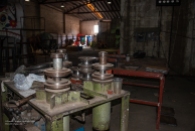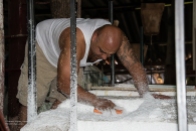Ironically, change can sometimes be the best way to honor tradition. And holding inspiration and love for tradition in your soul can bring about the most remarkable innovations and creativity. This year, CULTURA Mazatlán’s desire to bring in younger, fresher, more modern and innovative blood has been a surprising and welcome way to honor our community tradition—what the protagonist of this story calls our “religion.”
You will have heard of Ocean Rodriguez, the young mazatleco who left town 14 years ago to make it big in set design in Mexico City and who has come home to be one of three Carnaval float designers this year. The new city administration has been singing his praises so highly since coming into office that my response to meeting him was, honestly, skeptical. Were we about to meet another over-confident ego? Thankfully that was not at all the case. And, after our community disappointment with the monigotes, I know many of you are worried about the quality of the parade this year.
Touring Ocean’s workshop with him took our breath away, and I don’t say that lightly. We saw intricately detailed, lifelike sculptures, painted in vivid colors and finished in the glitter that is a requirement of a mazatlecan Carnaval parade. We saw a bit of Las Vegas, in the way lightbulbs were used to add flare to large letters. We were awed by moving parts and mechanisms, including machines and a whale spouting. A successful set designer, as Ocean told us, is part “architect, sculptor, mechanic, painter and carpenter,” a jack of all trades or a renaissance artist. I am posting photos of details, only, as CULTURA has requested the press not post photos of Carnaval floats before the parade, so that the public can be surprised and delighted. Click on any photo to enlarge it or view a slideshow.
Talking with Ocean was a delight. He treasures the uniqueness of Carnaval de Mazatlán deep in his soul, in a manner remarkably similar to that of Maestro Rigo—the designer of our parade floats for 54 years. Ocean, in fact, credits Rigo as his earliest professional inspiration—standing on the street in awe, along with the rest of Mazatlán—of those Barroque-style carros alegóricos was one of the huge joys of his childhood. His grandmother, Emilia Zatarraín, would take him and his cousins to the parade. She was “muy carnavalera,” and from December till Mardi Gras would save egg shells to make cascarones filled with confetti and serpentine, giving each of her grandchildren a “Carnaval kit” every day during the maximum fiesta of our port. Ocean is dedicating the eight floats he is building this year to her memory. And, while the city points to the Lewis family’s creations as honoring Maestro Rigo’s legacy, I believe you can add Ocean’s eight floats to that list. In Ocean’s creations we saw the details, complexities and whimsical surprises that we had been fortunate to witness every year in Maestro Rigo’s workshop, but updated, made with modern techniques, feeling familiar and yet very fresh and new. Kudos and thanks to you, Ocean!
Perhaps most surprisingly is that his workshop was relaxed, joyful. There was none of the last-minute panic, the long days and nights of endless work, that we were so used to experiencing in a Carnaval float workshop. It may have been show, but I believe it’s thanks to the wonders of 3-D printing and modern rendering, as opposed to the gorgeous yet time-consuming artistry of papier maché. Most of the pieces of all eight floats appeared to be nearly ready to assemble, calmly and ahead of schedule!
This year is a dream come true for this young mazatleco, whose most fervent desire is to make his birthplace his home. Having raised a son here who shares that most heartfelt of desires, I know how limited the options for making a living in Mazatlán can be, and sincerely hope that Ocean, who is building a house here, will make Mazatlán his base and continue his internationally renowned career from here. Ocean graduated from ICO, is divorced, and has all his family here in town. He’s designed sets for movies, television (Shark Tank Mexico and many others) and musical tours (Yuri, Enrique Iglesias, David Bisbal…), as well as commercials for some of the world’s most major brands (Pepsi, Burger King…) with the company he founded, Artefacto Sets. Below is one of their promotional videos.
Touring a Carnaval float workshop evokes emotions similar to what I imagine touring Willy Wonka’s chocolate factory must feel like. We visited Maestro Rigo’s workshop every year and have visited Maestro González Neri’s several times as well. During the tour you feel excitement, delight, surprise, amazement, wonder… There are lathes and saws to cut wood; there are drills and torches to form metal; turbines, elevators and mechanical pieces; there is tons of Styrofoam, paint, and glitter, glitter, everywhere glitter. People talk of men coming home with lipstick on their collars. From what I can tell, in this industry, you come home with glitter in your hair and styrofoam in places you don’t even want to think about.
I so wanted to take photos of the floats to show you. Sadly, I couldn’t. But they are truly incredible! You will be delighted! As Ocean guided us around he’d say things like, “these are the birds’ wings here and they will go onto the crow there, and the crows will then be mounted to fly over the trees here, and the trees go….” Your imagination soars. The other really impressive thing, to me, is how the floats have elevators and telescoping elements. You see, they are assembled in workshops, which are a certain height. They need to drive out, or, rather, be pulled out, through the door or gate. They assemble the floats in order on Aleman street, and that is a second height. Then, the main Avenida del Mar, cleared of all low-hanging wires and street lights, is a third height. So, all the tall elements telescope out in at least three sections, like the giant drum / cake on the Banda el Recodo float: one part fits into another and those fit into a third. The push of a button enables things to move.
The theme, “Equinox: Awakening the Senses” was evident in every aspect of Ocean’s floats, albeit in creative ways. We saw:
- A shaman in the jungle, highlighting the importance of nature and the danger of climate change.
- The seasons of spring (a marine scene), winter (an epic struggle with an octopus) and fall (leaves, the autumn moon, and a boat).
- Huge numerals “80” for El Recodo’s 80thanniversary float.
- Gigantic statue of Prometheus, the Greek god who gave humans fire.
Ocean is doing the section for the King of Carnaval—renamed this year from King of Joy. We saw a delightful boat with a working paddle wheel, made entirely out of wood. Ocean began designing his floats in early October, and began producing the parts later that same month. He hired trailers to transport them here to Mazatlán a month ago, when he arrived with his team to begin work here in town. He tells us, “No one knows Carnaval like a mazatleco. I have 25 years of my life living and breathing Carnaval. It’s been a lifelong dream to design these floats. But no one is a prophet in their hometown. I had to establish myself in Miami, Bogotá, La Havana, before I finally got to come home to do what I do. I don’t regret that it took so long; I’m ready.”
While Maestro Rigo did things artisanally, with handmade papier maché, in Ocean’s workshop we see auto-cat, plotters, 3D printers, unicel, fiberglass molds, resin—a much higher tech way of creating his intricate, realistic yet fantastical designs that are so unique and yet echo the soul of a Lewis Carnaval. The pieces are still finished up artisanally—hand painted, and adding the glitter is a laborious process. He has hopes that we will see real fire spouting from one of the floats, but that will depend on Protección Civil’s permission. “The finishing with this method is finer, like sculpture. We can get details like fingernails, gestures, how the fabric moves…” Ocean didn’t know Maestro Rigo, though he did meet him once, briefly, when he was younger.
So what about this religion stuff? Why does Ocean say that Carnaval is the mazatlecan religion? “I had doubts about using glitter on my floats. Didn’t really want to. So I asked a few people. Put the question up on my Facebook page. I couldn’t believe the ferocity of the response!!! People demanded their glitter, said it wouldn’t be Carnaval without it. They had a fit, like I was breaking a religious truth. Every mazatleco is an art curator of Carnaval floats. Everyone born here can distinguish a good float from a bad one, and critique its elements, tell you what’s missing. What do you call it, if not a religion, when people stand in line over 24 hours to get free tickets for the coronations? What do you call it when they put their chairs out three days ahead of the parade, and spend 24 hours per day guarding their space, if not a religion?”
Religion or not. Carnaval de Mazatlán rocks, and the 2019 parade looks to be no exception I trust you’ll join me, dancing in the streets!
—
This is the first in a series on the 2019 Carnaval de Mazatlán floats. The second, on the Lewis Family taller, is here. The third and final, about Jorge Osuna’s workshop, is here.





















Wonderful article!
Thanks, Claire. Such a relief, and a thrill, to see this workshop.
Pingback: Cultures Grow on the Vine of Tradition | ¡VidaMaz!
Pingback: Give Me a Light? | ¡VidaMaz!